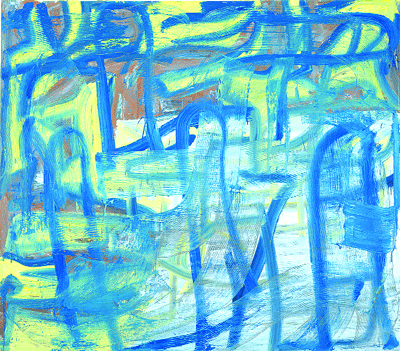Louie Fishman flexes to the limits of her physical expanse
In her third exhibition of paintings at Cheim & Read Gallery, Louise Fishman presents 15 new works dating from 2003 to 2005. This is gestural abstraction in the flesh—straight up—and it’s wonderful. There is an intense urge to describe the work as masterful. Any impulse to resist might only be justified by an attempt to hold the door open to those who are still attached to dismissing notions of mastery. But it is clear that the artist would not mind my urge. “Heroic Deeds,” 2003, the smallest and perhaps most intense painting in the show, makes plain Fishman’s full embrace of grand ideals.
It is more than a fleeting pleasure to encounter work that does not shrink from the power and importance of conviction, making evident years of complex yet directed inquiry.
Each canvas is monumental in feeling, but not necessarily in size. None measure much more than seven-feet in any direction. Most are a bit smaller. And while these are big paintings, they are not architectural. The monumentality is conveyed initially as a force—movement of the body lodged in the gestures of making—bound by the confines of a surface linked to the dimensions of the maker’s body. She pushes, bends, trowels, and flexes into spaces that pull her to the limits of her own physical expanse. Building layer upon layer, stroke upon stroke, Fishman chooses tools that are often broad and likely heavy. Indications of duration and weight compound the charged muscularity here. Gestures result in marks that bend on and off a presumed grid, with hints of a language somewhere between the early pictographic grids of Adolf Gotlieb and the dynamic compositions of Franz Kline.
Paint behaves as Fishman would have it—sticking, skeining, scraping, lolling into and onto figures, or colliding into stacks and masses. And color is born by particular accumulations rendered whole by the surface. It is a gloriously dirty business, pulling us further from the desire to describe and closer to the possibility of emotional response.
Fishman moves her body into each canvas with certainty, just as she moves her vision into the history of painting. Her contribution to the form surpasses that which can be grasped from an air-kiss with abstract painting while it enjoys favorable light. Many have, for some time, acknowledged the particular significance of work produced from her specific position of “painter” + “ lesbian“ + “feminist.” She proves an excellent model to all young artists—one who would follow her practice with tenacity into realms made intensely problematic by popular critical discourse.
David Deitcher ‘s essay, in the catalogue that accompanies the exhibition, illuminates Fishman’s journey through receptions governed by critical prescription, and begins to build a richer understanding of this great work. He begins the text with an argument for seeing the work in person. I totally agree.
gaycitynews.com



































